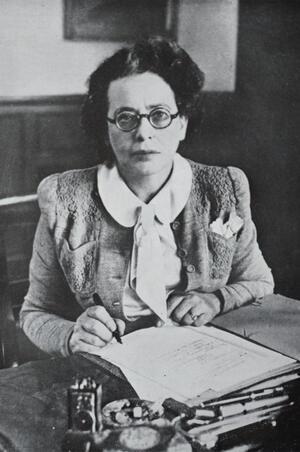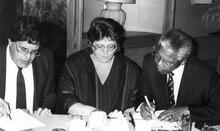Sarah Gertrude Millin
Sarah Gertrude Millin was born in Lithuania but moved to South Africa as a baby, where her upbringing in an impoverished region influenced her later literary work. At twenty-two, she married, moved to Johannesburg, and wrote her first novel. Her fourth novel, God’s Step-children, was the first that reflected her racial prejudice as a central theme. She published a plethora of novels pertaining primarily to South Africa’s people. Although Millin was an ardent Zionist, few of her publications reflected her profound interest in Jewish history. Her final works reflected her increasingly right-wing views supporting apartheid politics, tainting her literary reputation.
For more than thirty years Sarah Gertrude Millin was South Africa’s leading literary figure. In a prolific writing career that began in 1919 with the publication of her first novel, The Dark River, she produced sixteen more novels, two major biographies, two autobiographies, six war diaries, a volume of short stories, a collection of essays and a sociological account of South Africa. Her reading public spanned continents. In particular, her 1924 novel, God’s Step-children, with its central theme of the “sin” of miscegenation, brought her to the attention of the reading public in the United States. However, the racism of that view and her conservative political attitudes in general have detrimentally affected her status in South African literary history and present a challenge to a genuine critical assessment of her work.
Early Life
Sarah Gertrude Liebson, who was born in Zagar, Lithuania, on March 19, 1889, was one of a family of seven children. Five months later her parents, Isaiah and Olga, immigrated to South Africa and the family settled in Beaconsfield near Kimberley. In 1894, when she was six years old, they moved to the diamond diggings on the banks of the Vaal River in the Kimberley area where her father opened a trading store. This environment was to provide the setting for much of her future work that combined a love of the South African landscape with an abhorrence of the poverty and squalor in which most of the diggers lived.
After matriculating at Kimberley High School for Girls in 1904 she chose not to take up the bursaries offered to her to attend the university at the South African College in Cape Town but instead studied music in Kimberley. She obtained a piano teacher’s certificate but never practiced that career. From the age of six she had been convinced that writing was her destiny and had begun writing short stories at an early age. Some of her first compositions appeared in newspapers in the years 1910 to 1912.
Themes of Miscegenation and Racism
On December 1, 1912, she married Philip Millin and they settled in Johannesburg. Philip, a lawyer who later became a judge of the Supreme Court, encouraged her literary ambitions. The Dark River appeared in 1919. Set in the diamond diggings, this novel introduced the theme of miscegenation that was to surface in much of her later writing.
Millin published a novel a year over the next three years but it was in her fourth novel, God’s Step-children (1924), that she used this firmly held prejudice as a central theme. In the novel, a missionary, Reverend Andrew Flood, marries a Hottentot (the name given by the Dutch settlers in the seventeenth century to the indigenous inhabitants they encountered at the Cape) and fathers two children. As a result, he sinks into squalor and madness, obsessed with the “sin” of having begotten half-caste children. This “sin” is then traced through four generations, with each generation, although whiter in complexion, remaining equally frustrated in its desire to enter white society. Millin’s conviction is obvious—there is no escape from the effects of what is, for her, the original sin of South African society.
In 1923 and 1925 Millin and her husband traveled to England and Europe, where Millin made the acquaintance of several literary luminaries of the time including D. H. Lawrence and G. B. Shaw. Despite frequent trips abroad until her death, Millin’s literary output continued unabated. Her first non-fiction book, The South Africans (1926), revised and enlarged in 1934 and republished in 1951 as The People of South Africa, was extremely well received at home and earned her the local recognition that had previously eluded her. This impressionistic account of South Africa’s history provides many examples of the racial attitudes that were to detract from her place in South Africa’s literary history.
International Success
Two more novels were published in 1928, one of which, The Coming of the Lord, is the only one of her novels that touches on her Jewishness. Set in the small town of Gibeon, the book explores the nature of the society and its minority groups including Indians and Jews. The year 1930 was marked by a highly successful trip to the United States of America where she was lionized as a literary celebrity. Through her friendship with the South African politician General Jan Smuts, Millin was received by President Hoover and was also the house-guest of Franklin and Eleanor Roosevelt.
Her Biography of Cecil Rhodes (1933) was extremely well received and was filmed under the title of Rhodes of Africa in 1936. Her friendship with Smuts (Prime Minister of South Africa from 1919–1924 and 1939–1948) and her access to the Smuts family papers resulted in the publication of the Biography of General Smuts in 1936.
Zionism
During the 1930s Millin became increasingly preoccupied with international politics, particularly with the rising menace of Nazism. An ardent Zionist, she visited Palestine at the invitation of the Zionist leader Chaim Weizmann, who was to become the first President of Israel. In South Africa she was particularly angered by the absence of political opposition to a bill introduced into parliament in 1936 that would restrict the number of Jewish refugees allowed into South Africa.
After the publication of another novel in 1938, What Hath a Man?, Millin began to write the first volume of her autobiography, The Night is Long (1941). Between 1944 and 1948 she wrote six war diaries, one of which described the Nuremberg war crime trials that she had attended. Three more novels were published, including King of the Bastards (1950), which proved to be a best seller, feeding as it did into the notion of biological racism that had been the cornerstone of the political dispensation in South Africa since the National Party was voted into power in 1948.
Later Life and Impact
In 1952 the University of the Witwatersrand, Johannesburg, conferred an Honorary Doctorate in Literature on Sarah Gertrude Millin. The citation described her as “Par excellence the interpreter of South Africa to the English speaking world.” Soon after she received this award her beloved husband died and she became increasingly withdrawn and marginalized in both the literary and political worlds. The second volume of her autobiography, Measure of My Days (1955), revealed a bitter and resentful persona whose novel, The Wizard Bird (1962), confirmed her increasingly right-wing views and support for the National Party’s apartheid policies. She published one more novel—Goodbye, Dear England (1965)—and was planning a visit to London to find a publisher for its sequel when she died in Johannesburg on July 6, 1968, at the age of seventy-nine.
Although not a believer in religious rites and prayer, Sarah Gertrude Millin had a deep pride in her Jewish heritage and a profound concern for the fate of the Jewish people. She possessed a very detailed knowledge of Jewish history and among her unpublished work at the time of her death was a history of the Jews.
She took a profound interest in current Jewish issues and used her connections with prominent South African politicians such as General Smuts and Jan Hofmeyr to curb the fascist Greyshirt movement in South Africa.
Millin, who had no children, left behind a substantial body of work that impacted on the historical development of the English language in South African fiction, but her legacy was tainted by her views on questions of race.
Selected Works by Sarah Gertrude Millin
The Dark River. London: 1919, New York: 1920.
Middle Class. London: 1921.
Adams’s Rest. London: 1922. New York: 1930.
The Jordans. London: 1923, New York: 1923.
God’s Step-children. London: 1924, New York: 1924.
Mary Glenn. London: 1925, New York: 1925.
The South Africans. London: 1926, New York: 1927. Revised and enlarged edition, London: 1934. Revised as The People of South Africa. London: 1951, Johannesburg: 1951, New York: 1954.
An Artist in the Family. London: 1928, New York: 1928; The Coming of the Lord. New York: 1928, London: 1928.
The Fiddler. London: 1929, New York: 1929.
Men on a Voyage. London: 1930.
The Sons of Mrs. Aab. London: 1931, New York: 1931.
Cecil Rhodes. New York and London: 1933. Republished as Rhodes. London: 1933. Revised ed. London: 1952, Cape Town: 1952.
Three Men Die. New York: 1934, London: 1934.
General Smuts. 2 Vols. London: 1936, Boston: 1936.
What Hath a Man? New York and London: 1938.
The Night is Long. London: 1941.
The Herr Witchdoctor. London: 1941. Republished as The Dark Gods. New York and London: 1941.
South Africa: The British Commonwealth in Pictures. London: 1941.
War Diary. Six volumes. London: 1944–1948.
King of the Bastards. New York: 1949, London: 1950.
The Burning Man. London: 1952, New York: 1952.
Measure of My Days. Johannesburg: 1955, London: 1955, New York: 1956.
Two Bucks Without Hair: And Other Stories. Johannesburg: 1957, London: 1957.
The Wizard Bird. London: 1962, Johannesburg: 1962.
Goodbye, Dear England. London: 1965.
Bernstein, E. Memories of Sarah Gertrude Millin. New South African Writing. Cape Town: 1968.
Braude, Claudia Bathsheba, ed. Contemporary Jewish Writing in South Africa, Lincoln and London: 2001.
Braun, L. “Not Gobineau but Heine—not racial theory but biblical theme: the case of Sarah Gertrude Millin.” English Studies in Africa 34 (1) 1991: 27–38.
Coetzee, J. M. “Blood, Taint, Flaw, Degeneration: The Novels of Sarah Gertrude Millin.” English Studies in Africa 23 (1) 1980: 41–48.
Jaff, Fay. Women South Africa Remembers. Cape Town: 1975.
Leveson, Marcia. People of the Book. Images of the Jew in South African English Fiction 1880–1992. Johannesburg: 2001.
Rubin, Martin. Sarah Gertrude Millin: a South African life. Johannesburg: 1977.
Snyman, J. P. L. The Works of Sarah Gertrude Millin. Johannesburg: 1955.
Scanlon, Paul, ed. Dictionary of Literary Biography: 235 South African Writers. New York: 2000, 270–282.




